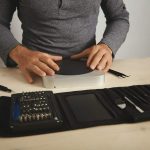In the realm of driving, the importance of properly adjusted mirrors cannot be overstated. Mirrors are the eyes at the back of your head that you desperately need while on the road. As drivers, you should have a comprehensive field of vision which includes the area behind and on either side of your vehicle. The key to achieving this is the correct adjustment of your car’s side mirrors.
This article aims to guide you on how to adjust the side mirror angles of your hatchback for optimal blind spot elimination. With appropriate mirror adjustment, you will have an improved view of your surroundings, leading to safer driving experiences.
Also read : What are the critical safety tips for driving a fully loaded minibus?
Understanding the Blind Spot
The term ‘blind spot’ refers to the areas around your vehicle that you cannot see while looking forward or through the rear-view or side mirrors. It has been the cause of countless accidents as the driver, oblivious to the presence of another vehicle or obstacle, changes lanes or makes turns.
Ensuring that these spots are minimized or even eliminated is crucial for your safety and the safety of others on the road. It’s important to understand that while technology like blind spot detection systems can help, they should not replace good old-fashioned visual checks and correctly positioned mirrors.
Also to see : How should you adjust the suspension settings of a race car when driving on a wet track?
Proper Positioning of the Driver
Before we delve into adjusting your mirrors, let’s first focus on your seating position. Your mirrors can only help you spot cars and objects if you are seated optimally.
Your head should be positioned such that the roof of the car is in your peripheral vision. The driver’s seat should be adjusted so that you can reach the pedals comfortably and your arms are slightly bent while holding the steering wheel.
Your rear-view mirror should provide a clear view of the back window. Remember, adjustments to the side mirrors will be based on this initial position. Any subsequent changes to your seating position would need a re-adjustment of the mirrors.
Adjusting the Side Mirrors
Once you are comfortably seated and your rear-view mirror is adjusted, it’s time to focus on the side mirrors.
For the driver’s side mirror, lean to your left so that your head is almost touching the window. Now adjust the mirror until you can just barely see the edge of your car in the right side of the mirror.
For the passenger’s side mirror, lean to your right towards the center of the car and adjust the mirror until you can just barely see the edge of your car in the left side of the mirror.
This way, you will extend your field of vision as far as possible and reduce the blind spots significantly.
Checking for Blind Spots
After adjusting your mirrors, it’s time to check their effectiveness in eliminating blind spots.
While parked, observe a passing car in your rear-view mirror as it approaches from behind. As the car leaves your rear-view mirror, it should appear in your side mirror. As it leaves the side mirror, you should be able to see it with your peripheral vision.
If there is a point at which the passing car is invisible, readjust your mirrors as necessary until the blind spot is eliminated.
The crucial point to remember is that your side mirrors are not for looking at the side of your car, but to view the road behind you. They should, therefore, be adjusted outwards until the viewing angle overlaps with your peripheral vision.
In Conclusion
Adjusting your mirrors is not a one-time task. It should be done every time you get behind the wheel, especially if there are multiple drivers using the same car. If you want to ensure your safety and that of others around you, make sure your mirrors are always correctly positioned.
Mastering the Art of Mirror Checks
In order to ensure blind spots are truly eliminated, it’s crucial to master the art of mirror checks, even after adjusting the side mirrors. It’s not just about the right positioning of your car mirrors, but also knowing when and how to check them.
Firstly, drivers must remember to check their mirrors every 5-10 seconds. This doesn’t mean a lengthy gaze but rather a quick glance to assess the situation behind and beside your vehicle. This will help you maintain awareness of your surroundings and spot any vehicle that might have moved into your blind spot.
Secondly, remember to check your mirrors before you make any changes in direction. This includes before you signal, brake, change lanes, or turn. If you master the habit of checking your mirrors before making a move, you’ll be more likely to spot a vehicle in your blind spot.
Lastly, it’s important to remember the ‘over-the-shoulder’ check. Even with your mirrors correctly adjusted, there may still be a small blind spot. So before making any significant move – particularly changing lanes – it’s always a good idea to quickly turn your head and check over your shoulder. This will cover the areas that your mirrors may not be able to capture.
The Importance of Regular Adjustments
Making it a habit to adjust your mirrors each time you get in your vehicle is just as important as adjusting them correctly in the first place. This is particularly true if you share your car with another driver. Since everyone has a different height, seating preference, and peripheral vision, the optimal mirror setting for one driver may not work for another.
Begin by adjusting your driver’s seat to your preferred position. Then, set your rear-view mirror so that it best captures the view through the rear window. Once your rear-view mirror is set, proceed to adjust your side mirrors as detailed in the previous sections.
Remember, your side mirrors are not for looking at the sides of your car, but to extend your field of vision towards the rear. Therefore, they should be adjusted in such a way that the view they provide slightly overlaps that of your rear-view mirror.
Conclusion
In conclusion, the art of eliminating blind spots lies not just in adjusting your mirrors correctly, but also in mastering the art of mirror checks and making regular adjustments. The correct adjustment of your side mirrors and the ability to check them effectively can significantly enhance your field of vision and thereby reduce the risks associated with blind spots.
Always remember, safety on the road hinges on the ability to see and be aware of everything around you. Therefore, the time and effort dedicated to adjusting your mirrors and checking them frequently are indeed worth it.











